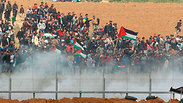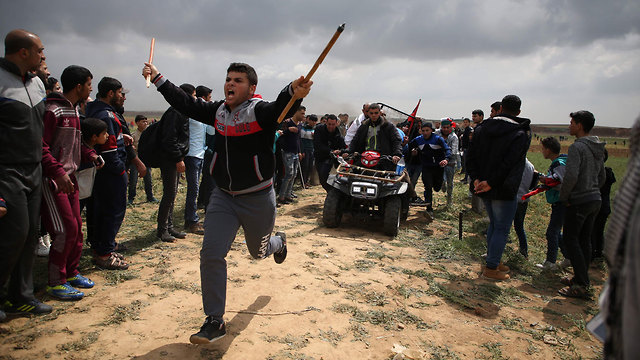
The protests, largely led by Gaza’s Hamas rulers, began March 30. Organizers said they’ll gradually move the camps toward the fence until May 15, but made conflicting comments about a possible breach.
Hamas says the protests are aimed at breaking a crippling border blockade that was imposed by Israel and Egypt after the Islamic militant group overran the territory in 2007, a year after winning Palestinian parliament elections. The marches also press for the return of the descendants of hundreds of thousands of Palestinians who fled or were forced from homes in the 1948 war over Israel’s creation.
While some organizers portray the protests as peaceful, Hamas and representatives of other factions have made it clear that a border breach is being considered.
“We will cross the border,” said Daoud Shehab, a member of the organizing committee from the smaller Islamic Jihad group, adding that Israel “should feel really jittery as a result of these marches.”
Israeli military officials have warned that they will not tolerate a mass border breach or permit protesters to get close to the fence. Israel’s military said Thursday that it is ready for all scenarios and is “prepared to prevent any breach of Israeli sovereignty or damage to the border fence.” Several Israeli communities are close to the border.
Rights groups have branded Israel’s open-fire regulations as unlawful, saying they permit soldiers to use potentially lethal force against unarmed protesters.
In the past three weeks, Israeli troops firing from across the border fence have killed 28 protesters and wounded more than 1,500, according to Gaza health officials.
During the weekly Friday marches, most protesters have remained in the five sit-in tent camps, but smaller groups have moved toward the fence, throwing stones, hurling firebombs or burning tires.
On Thursday, organizers moved tent camps several dozen meters closer to the fence.
In a camp east of Gaza City, five tents were moved to within 300 meters (328 yards) of the border, just in range of tear gas volleys. Bulldozers also raised protective sand berms around the new tents. In another protest site in southeastern Gaza, earth mounds were created to define the camp’s new boundary.
Meanwhile, activists were testing new means of confronting Israel — kites with burning rags dangling from their tails. The aim is to set ablaze drying wheat fields on the Israeli side.
In the camp near Gaza City, activists flew two kites Thursday. One fell short in Gaza. The other reached its destination but failed to start a fire.
Several fires have been started in wheat fields on the Israeli side of the border by such contraptions in recent days, according to the Times of Israel news website.
The Facebook page of the Gaza protest organizers published images Wednesday of Israeli fields behind the fence, taken from a small camera attached to a kite.
Thursday’s development came as Israel was celebrating 70 years since the modern Jewish state was established.
Festivities began the night before when in sharp contrast, Israel abruptly crossed over from its melancholy Memorial Day for fallen soldiers and terrorism victims.
The grouping of the two days is intentional, to show the link between the costly wars Israel has fought and the establishment and survival of the Jewish state.


















